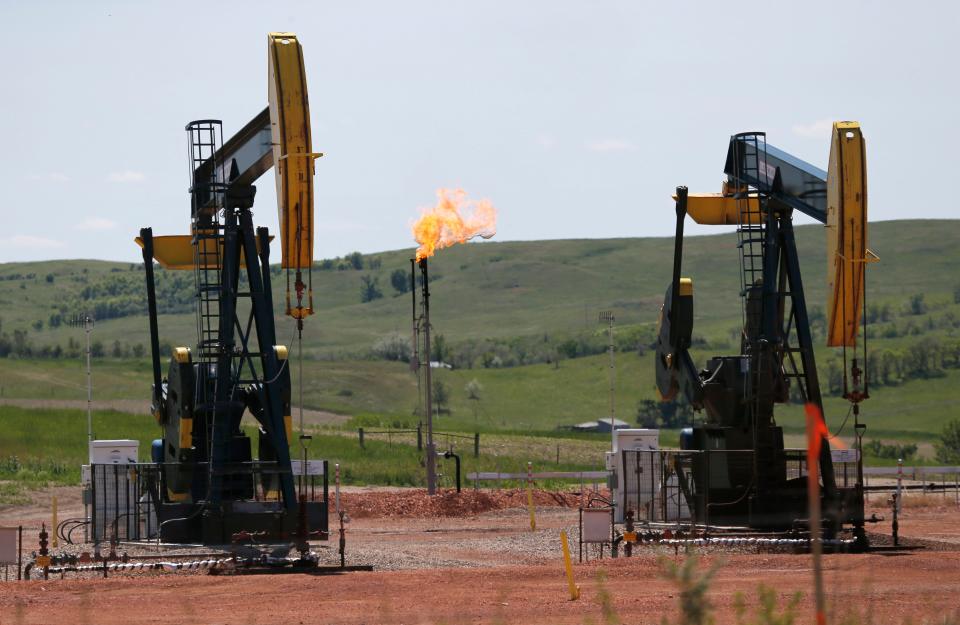Biology: Despite congressman's claims, natural gas is neither green nor clean
- Oops!Something went wrong.Please try again later.

“I’ve got a woman calling love hate” — Eric Clapton, “Promises” (1978)
I’ve got a representative calling natural gas great.
Can you relate?
Earlier this month, my United States Representative, Troy Balderson, a Republican from Zanesville, announced “a resolution he introduced…in the House of Representatives officially recognizing American natural gas as a ‘green and clean’ energy source.”
It’s neither.
Methane, the primary component of natural gas, is 25 times more potent than carbon dioxide as a greenhouse gas. It only stays in the atmosphere for about 12 years. We’d see quick returns on investments to limit its emissions now.
More: Ohio transit agencies face high hurdles in quest to reduce carbon emissions from buses
Burning natural gas to generate power is, indeed, cleaner than coal. Then again, so is (clean and green?) oil.
Rep. Balderson’s news release notes that natural gas "(is) abundant right here under our feet … in Ohio."

Not all that methane, wherever it’s mined, makes it from underfoot to combustion in a power plant.
Newly developed technologies permit real-time visualization of methane leaks. Infrared cameras detect methane plumes spewing from storage facilities, pipeline connections, and even cattle feedlots.
More: Letters: Sen. Rob Portman's vote for methane regulations a win for environment
Similarly, NASA and a consortium of universities is developing satellite technology to identify methane emission sources from space.
Studies using these cutting-edge technologies reveal that we have underestimated methane leakage from industrial sources by up to 40%.

Methane, like all fossil fuels when burned emits microscopic, airborne particles. The smallest measure just 2.5 microns across. One of our red blood cells could wear a necklace of eight of them. At that size, they can escape our capillaries into our tissues, causing asthma, cardiovascular disease, and cancer.
Indeed, given the preponderance of “homegrown” coal and natural gas in generating our power, Ohio has a relatively high rate of deaths caused by fossil fuel combustion emissions.
I enjoy reading books to our 16-month-old grandchild. Our favorites include Baby Loves Thermodynamics. The publisher recommends it for children 0-3 years. It’s likely within grasp of most members of Congress.
The sun shines on the tree. It helps the tree grow.
How does the sun help the tree grow? By giving it energy!
Sunlight + air + water = food for the tree.
The tree uses the sun’s energy to grow an apple.
Baby eats the apple. Yum!
What’s that “air”? Carbon dioxide.That apple? Sugars or molecules derived from them.
If baby doesn’t eat the apple, it falls to the ground. The whole tree will eventually do the same. If submerged or otherwise buried, that apple and everything else derived from those sugars may become fossil fuels over hundreds of millions of years.
When finally mined and maybe burned, those fossilized apples and other parts emit greenhouse gases, including methane and microscopic particles.
According to Open Secrets, oil and gas interests contributed over $160,000 to Rep. Balderson’s last two campaigns.
Some consider natural gas a “bridge fuel” to a future when we only generate power from renewable sources such as solar and wind. But with fossil fuel industries bankrolling members of Congress, one wonders if this may be a bridge fuel to nowhere new.
Instead of sticking their heads in oxymoronic boreholes, we need policymakers proposing legislation anticipating the economic dislocations, challenges, and opportunities of the energy and transportation revolutions already underway in Ohio.
Steve Rissing is professor emeritus in the Department of Evolution, Ecology, and Organismal Biology at Ohio State University.
steverissing@hotmail.com
This article originally appeared on The Columbus Dispatch: Columnist: Natural gas no solution to global warming

